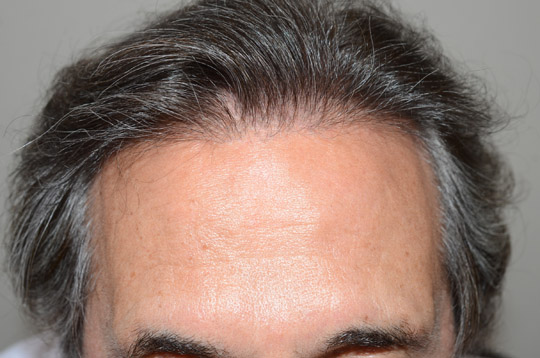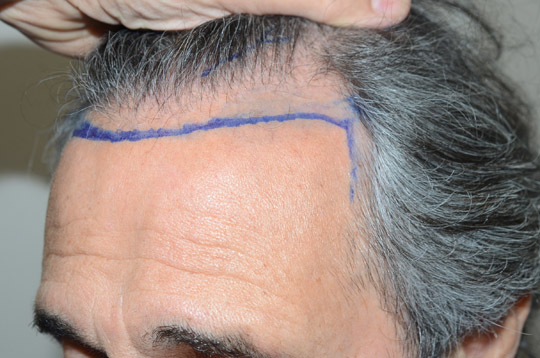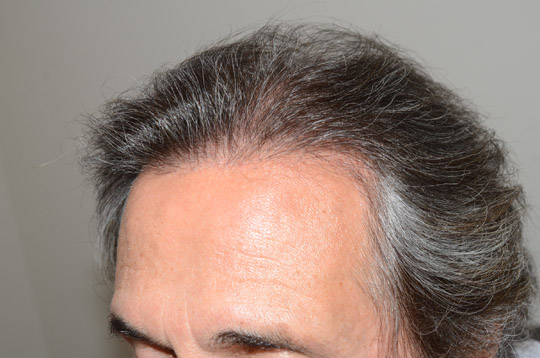Hair loss can be a frustrating and challenging experience for anybody, particularly for men and women who feel as though their hair is an important part of their cultural or self-identity.
Types
ACTUAL PATIENT
Restoring Confidence, One Hair at a Time
Depression and anxiety are very real consequences of hair loss, and studies show that people who lose their hair are more likely to experience negative psychological effects, like low self-esteem, intense emotional suffering, and social isolation. That’s not to say, however, that hair loss is totally uncommon or taboo. By age 35, approximately 40% of men will experience visible hair loss, and around 50% of women will start losing hair by the time they reach 50. But just because hair loss is common doesn’t mean you have to sit back and watch it happen.
Over the past 20 years, advances in medical sciences have paved the way for new and improved hair restoration techniques that yield beautiful, long-lasting results that look and feel just like the real deal. Dr. J. Epstein and his team are proud to be at the forefront of hair restoration technology, having performed tens of thousands of successful hair transplants for clients who come to his practice from across the country and internationally looking for outstanding care and impressive results.

What Types of Hair Transplants Are Available?
Hair restoration techniques can be divided into two categories: surgical and non-surgical.
Non-surgical approaches, like medications, topical products, and minimally-invasive interventions such as laser and platelet-rich plasma (PCP) aren’t considered actual hair transplants because they don’t involve transferring or implanting hair. But these techniques can be great alternatives for people suffering from hair loss that don’t qualify for surgical hair transplantation.
Surgical techniques do involve transplanting hair from one region to another and are considered the gold standard of hair restoration. There are two main types of hair transplants: FUE, or follicular unit extraction, and follicular unit transplantation, also known as FUT. They both achieve the same natural results and use similar methods for implanting hair into balding areas, but differ in how the follicles are extracted from the donor area.
Surgical Hair Transplant Techniques
FUE Hair Transplant
Follicular unit extraction, sometimes known as follicular unit excision, or simply FUE, is a hair transplantation technique that involves manually extracting hair follicles from the scalp or other areas. The extracted follicles are then strategically implanted into the recipient site or sites — typically the hairline or the top of the head — one by one to create a fuller, thicker appearance.
In FUE transplants, the surgeon uses a hand-held device to harvest hair follicles individually. The device makes a tiny, less than 2 millimeters in diameter, circular wound around each follicle to extract it all in one piece, leaving no visible linear scarring after the procedure.
One of the advantages of the FUE technique is that it can be used to graft hair from almost anywhere in the body, like the beard, chest, and legs, to transplant it into the scalp or other areas, such as the eyebrows. This groundbreaking solution, known as body hair transplant or BHT, provides patients who originally had no viable scalp donor hair with an exciting opportunity for hair restoration that wasn’t previously available to them.
Advantages of FUE Hair Transplants
- No linear scarring – unlike other methods, such as FUT and the traditional “hair plugs,” which are rarely if ever used anymore, the FUE technique leaves no visible scarring. This is because the follicles are harvested one by one in a diffuse or random pattern that makes the already tiny scars even easier to conceal throughout the donor area.
- Faster healing time – because it doesn’t involve any linear incisions, patients undergoing an FUE hair transplant don’t have to worry about taking care of stitches or sutures. This allows for a faster recovery period and little to no disruptions to their daily routines.
- Nearly painless – another advantage of not using scalpels or stitches is that patients report feeling almost no pain after the procedure. Most patients describe the next-day discomfort as a sensation similar to a sunburn.
- No-shave FUE – while some FUE procedures call for shaving the donor area, no-shave FUEs, sometimes referred to as “long-hair FUEs,” are possible for small cases under 1500 grafts.
- Can be used to conceal scars – FUE hair transplants are a fantastic alternative for camouflaging scars. Since hair grafts can be implanted directly into scar tissue, many patients opt for an FUE transplant to hide a visible scar left behind by a previous hair transplant procedure, accident, or surgical intervention.
Disadvantages of FUE Hair Transplants
- Time-consuming – FUE hair transplants require a lot of time and skill. This is because each hair follicle must be individually extracted and inspected to ensure its viability. While this yields superior results and less scarring, the process can take several hours to more than one session, depending on the number of grafts needed.
- Costlier than other methods – the level of expertise and time commitment makes FUE hair transplants more expensive than other methods. Some practitioners use robots to cut down costs and extraction time. But, the truth is, only providers with little experience in FUE hair transplantation offer robotic surgery. Among its many disadvantages, current robotic FUE procedures produce unnecessarily large wounds, have poor yields, and lower success rates.
FUT Hair Transplant
In the follicular unit transplantation technique, otherwise known as FUT or the “strip” method, all the necessary donor hairs are harvested at once by taking a thin linear strip of skin from the back of the scalp. Staples or sutures are then used to close the incision before carefully extracting the individual hair follicles from the strip and dissecting them to ensure they are viable for transplantation. After extraction, each hair follicle is individually implanted into areas of the hairline or scalp that are balding or thinning.
FUE hair transplants have the advantage of yielding a higher number of grafts in very little time. And because the grafts are isolated from a strip of skin and not directly from the patient’s body, the follicles carry a lower risk of damage during the extraction process. One big drawback of the FUT technique is that it leaves behind a noticeable linear scar that can be hard to conceal, especially among patients with short hairstyles.

Advantages of FUT Hair Transplants
- The highest yield of grafts – FUT is a great option for individuals suffering from advanced hair loss that require a larger number of hair grafts. And since grafts are collected from a single strip of hair, the entire process is significantly shorter than with the FUE technique.
- Partial or no shaving required – the FUT technique doesn’t require extensive shaving, so patients can go back to their regular activities after surgery without any major differences to their appearance.
- Lower price than FUE – FUT procedures is shorter and less labor-intensive, making them less expensive than FUE surgeries.
- Natural-looking results – like the FUE technique, FUTs involve manually transplanting individual hair follicles into the recipient site, mimicking the natural hair growth pattern for the most natural and realistic results.
Disadvantages of FUT Hair Transplants
- Visible scarring – one of the most significant disadvantages of the FUT technique is that it leaves behind a visible linear scar that can be difficult to hide for some people. The scar can be concealed with long hairstyles, which is why FUT is more popular among female patients but isn’t ideal for folks with shorter styles.
- Slower recovery – FUT surgery involves creating and suturing an incision, so patients have to factor in the time it takes for the stitches to heal. It’s also important to refrain from doing any vigorous physical activity to keep the sutures or the wound from opening.
- Discomfort – since it is a surgical procedure, patients can expect some mild discomfort the days following the surgery. The location of the stitches (back of the head) can also make laying down or sitting on certain chairs uncomfortable for a few weeks.
What Type of Hair Transplant is Right for Me?
As you can see, the FUE and FUT hair transplant methods each have their unique advantages and disadvantages. But the good news is that if you’re considering a surgical hair restoration approach, there’s never been a better time to get one. Today’s hair transplants, both with the FUE and the FUT techniques, look nothing like the “plugs” people got in the ‘80s and ‘90s that yielded unreliable results and looked very strange from up close.
In fact, hair transplants look incredibly natural nowadays. The best hair transplant method for you will be the one that your doctor recommends based on the type and extent of your hair loss, your desired results, the number of follicular units required to achieve those results, and whether you’ve had other hair transplants in the past.
FAQs
How much does a hair transplant cost?
The cost of a hair transplant varies depending on the type of restoration (FUE vs. FUT), the number of grafts needed, the practice you choose, as well as other factors such as anesthesia and lab fees. Keep in mind that FUE transplants tend to be costlier because the technique is more time-consuming, as each individual graft has to be manually extracted one at a time.
How many grafts will I need?
It depends on the extent of your hair loss, your aesthetic goals, and the number of grafts available at the donor site. With FUE hair transplantation surgery, Dr. J. Epstein can transplant as many as 2,000 to 3,000 grafts in one sitting, which is often enough to address hair thinning in the hairline and frontal scalp.
Which method provides longer-lasting results?
Both the FUE and FUT methods permanently transplant healthy hair into balding areas, providing long-lasting results. And better yet, when hair is transplanted from the back of the head with either technique, the transplanted hairs will be resistant to dihydrotestosterone (DHT), a hormone closely related to balding and hair loss.
Does the type of hair change the technique used?
While some hair types may be more challenging to transplant than others (i.e., afro-type hair) because of the angle that hair follicles grow, a talented and experienced surgeon like Dr. J. Epstein has extensive experience performing FUE and FUT transplants successfully in all types of hair.
Which hair transplant technique is the safest?
While both techniques can be very safe in the hands of an experienced surgeon, FUE hair transplants carry fewer risks because they don’t involve incisions or stitches.
Are hair transplants painful?
Hair transplant procedures are performed under local anesthesia, so they aren’t painful. After FUE hair transplantation surgery, patients report experiencing swelling and light soreness for 5-7 days following the procedure, while FUT patients can feel moderate discomfort and swelling, particularly at the incision site, for 4-5 weeks.
What’s the success rate of hair transplants?
In the hands of an experienced, well-trained physician, hair transplants can have a success rate of 95 to 98% or more.
Contact Us For More Information
At Foundation Aesthetic Hair Restoration, world-renowned hair transplant specialist Dr. J. Epstein and his talented team have completed tens of thousands of successful hair transplants and counting.
Since both the FUE and FUT transplant procedures have their own benefits and drawbacks, our plastic surgeons take the time to personally discuss the details of each technique with every patient to help them decide which option is best for their unique situation.
ACTUAL PATIENT
Contact Us Today
Start Your
Journey
Have questions? Reach out today
for answers and more information.





